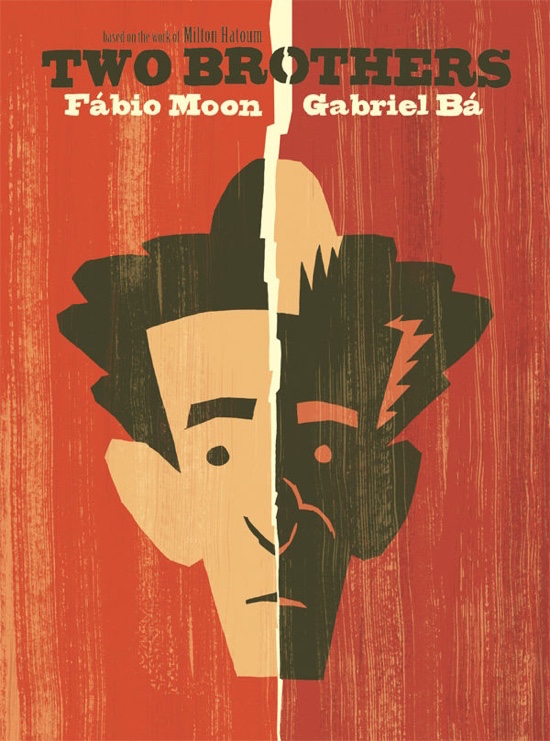Early in 2015 tQ’s comics coverage included Aug Stone’s visit to Angoulême for the annual comic festival. As I write this intro, a shit storm is well underway about the fact that the initial 30-strong long list of nominees for the Grand Prix (celebrating a lifetime contribution to comics) was entirely male. A third of the nominees withdrew themselves for consideration, the committee issued some generally unrepentant statements, grudgingly added some women to the list, and then abandoned it altogether for a free vote. I have no doubt this story will have developed further by the time this is published.
Reflecting both sexism at the festival and historically in the comics industry, it’s particularly inept timing to release a list like this after a year in which women won every category of the Ignatz awards. In the last few months we’ve reviewed books by Tillie Walden, Laura Knetzger, Gabrielle Bell, Emily Carroll, Jillian Tamaki, Anna Deflorian, Becca Tobin, Rachael Smith, Julia Wertz, Kate Beaton and Kat Chapman, and this is a pretty small selection of what has been published. Having only run this column for a few months I didn’t do a best of 2015 list but had I done so, a number of these would have been included. Bad move, Angoulême.
This month we’re still working through the releases from the end of last year.
Fábio Moon & Gabriel Bá – Two Brothers
(Dark Horse)
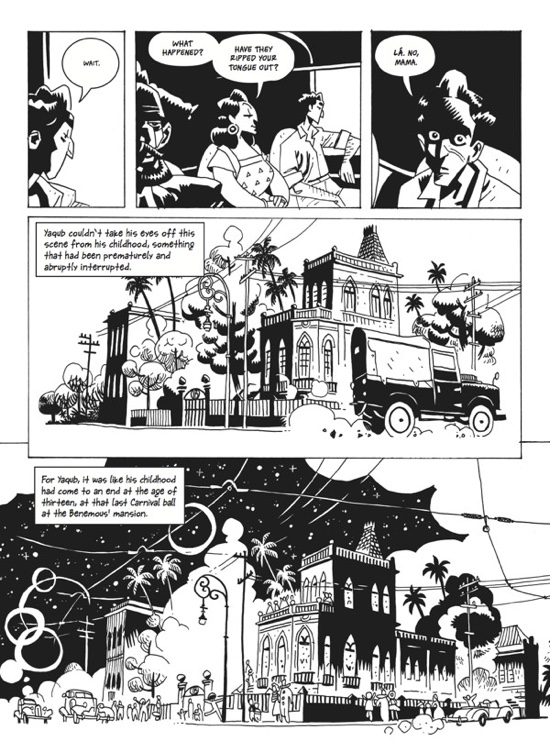
Twin brothers Fábio Moon & Gabriel Bá showed an unusual ability to grapple with profundity whilst avoiding cliché in Daytripper, their last book (if you haven’t read it I strongly recommend seeking a copy out for a life-affirming take on the inevitability of death). That was their material, drawn by Moon and in glorious colour. Here, the story isn’t their own, the drawings are by Bá and are in black and white, so on the surface Two Brothers is very different, but it’s still distinctively their work, striking on every page.
Two Brothers is a family epic spanning decades, centred on a mansion in the Amazonian city of Manaus, based on the bestelling novel The Brothers by Milton Hatoum. The siblings in question are twins, Yaqub and Omar. After a fight at a young age, Yaqub is sent to live in Libya while Omar remains in Brazil and is spoiled by Zana, his mother. When Yaqub returns some years later he is a stranger to his family and the divide grows, Zana siding with Omar and Halim, the father, with Yaqub. The black and white drawings are beautifully expressive, with sharp, straight lines and harsh angles depicting the arrogance and inflexibility of most of the characters. The locations are drawn with much more sympathy, and the overall effect is utterly absorbing. The book opens with a prologue of panels of establishing shots that recall the work of Seth in their pacing, yet present a totally different world through an equally different visual style. Moon and Bá start at the end, before beginning the story properly in the first chapter, by which time we are hooked.
As with any adaptation of a full-length prose novel into graphic form, much will have been excised to bring the story down to a manageable size. I’ve not read the original, but towards the end there is a section that seems a little rushed. There is a betrayal, and it happens very fast. This is a relatively minor criticism, however. Two Brothers is another superb work by two excellent cartoonists that shows their range as well as their talent. Pete Redrup
Julia Wertz – Drinking At The Movies
(Koyama Press)
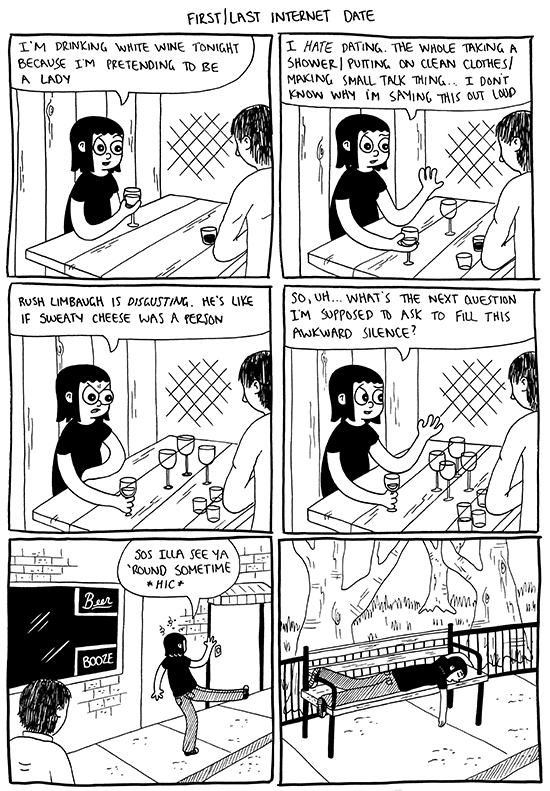
Drinking At The Movies, Julia Wertz’s first full-length work, was originally published in 2010 but has been out of print for a while. Now Koyama Press has reissued it with a new (and frankly quite bizarre) introduction by Janeane Garofalo that merits its own intro. If Wertz’s work begins with the puerile (the excellent, but definitely puerile Fart Party) and ends with the poignant (The Infinite Wait, from 2012), then this firmly sits in the middle. In part it’s a memoir of her struggles with alcoholism, in her trademark self-deprecating manner. It’s also an account of her move from San Francisco to New York and the various indignities that befell her as she moved from low pay low status job to low pay low status job, and from lousy apartment to lousy apartment whilst battling illness and the American healthcare system.
Wertz is one of the finest autobiographical comic artists. Instead of the overused woe-is-me approach, we are mostly invited to laugh at her misfortune, despite the fact that she is going through some very difficult times (her brother, living in San Francisco, is dealing with his own very serious substance use problems, as well as her own alcoholism, and Wertz hints at her feelings of guilt in leaving him to move to the other end of the country). This typically takes the form of a contrasting final panel on a page, jokey if the other panels have been sad, and vice versa. Her comic pacing is impeccable, the material never self-indulgent – there’s a huge difference between these public-facing diary pages and her private diaries from the time, a few pages of which have appeared elsewhere.
Although the art is simpler than that of many of her peers, it works well for this material, her character drawn with big eyes, heavy lids and frequently bedraggled hair. The limited repertoire of faces and facial expressions she uses is a strength rather than a weakness, depicting the generic appearance of generic character types, and contributing to the overall charm. At the very end is a selection of cityscape pages from her New York sketchbook, which are terrific. The story ends with a concluding page that wraps things up a little too neatly, which she has revealed in an interview as being at the insistence of her former publisher. Real life rarely resolves as neatly as that, particularly for those struggling with addiction, and Wertz published a comic essay on Narratively that shows what was left out of the account here. It seems the solitary life of the cartoonist is not helpful for someone trying to overcome a drinking problem. It’s not clear when, if ever, we will see new material. If it’s never, that’s a real shame as this is an excellent book by a very talented cartoonist, both moving and funny. Pete Redrup
Derf Backderf – Trashed
(Abrams ComicArts)
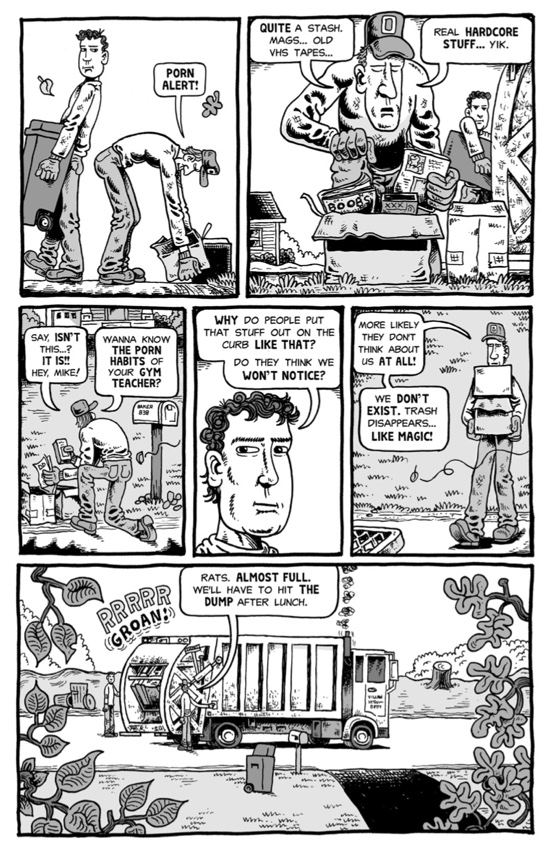
Trashed is the latest book from the splendidly-named Derf Backderf (John to his parents), best known for his memoir My Friend Dahmer, an account of being schoolfriends with a serial killer. Sticking firmly to the write-what-you-know school of thought, it’s a work of fiction but very much inspired by Backderf’s own experiences working in refuse collection. It started life as a webcomic before being expanded into this full-length graphic novel.
The book is about J.B. and Mike, a couple of young guys who take jobs on the trash crew in small-town America, and the various colleagues and citizens they encounter, such as Magee, the gravedigger dandy who is co-opted onto their team at busy times. It’s a small enough place that everybody knows everybody and these guys know their secrets. The trash crew lives a life in which being covered in garbage, maggots and sewage is a daily hazard, and the comic potential of this is fully exploited. At the same time, it’s full of social commentary and a thesis on waste management (tldr: consume less).
There’s a real 70s vibe about this – in some ways it reminded me of Richard Linklater’s Dazed and Confused – but it’s actually set in the present. This isn’t immediately apparent, however. The opening panel shows a disheveled bedroom with a vinyl copy of Zappa’s Sheik Yerbouti on the floor and an issue of Peter Bagge’s Neat Stuff. Backderf’s heavily-inked art is often compared to Robert Crumb, and this definitely helps contribute to the general air of comix, as does the seemingly randomly emboldened words, much like in Gilbert Shelton’s work. The wall mounted flatscreen TV and modern cars let us know that we aren’t in the 70s of the Zappa or the 80s of the Bagge, however, and later on we get a mention of Craigslist demonstrating the existence of the internet.
Trashed is divided into seasons. There are no textual intertitles, just pictures of seasonal trashcans. The story is essentially anecdotes about trash work with no real narrative arc, mixed with information about the waste management industry in the US. It’s a simple but effective balance where both wouldn’t necessarily work on their own but combine to produce an entertaining and informative book. Towards the end the narrative starts to run out of glue – a couple of times pages begin with ‘a few weeks later’ – but the book never overstays its welcome. Pete Redrup
Michael DeForge – Frontier 10
(Youth in Decline)
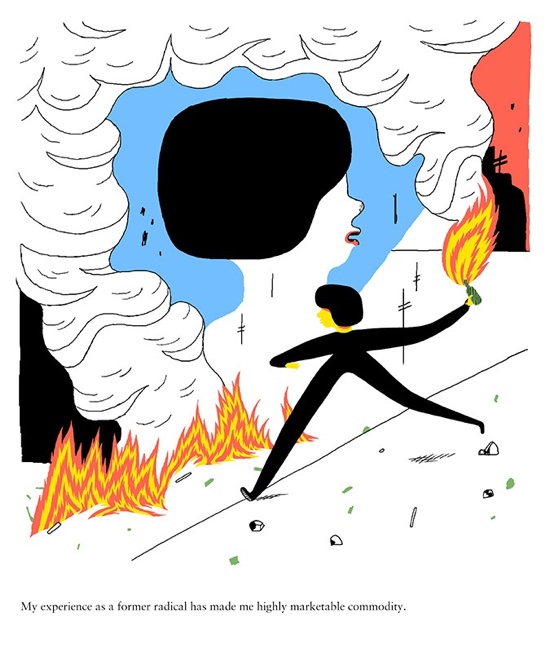
Bringing a superb year of releases to a close, Frontier #10 – Sensitive Property comes from Michael DeForge. The form is similar to his earlier work Actual Trouble (published in 2015 in Dressing) – full page borderless images with typed description below. The use of the present tense narration gives a noticeable directness and pace, and there is no dialogue, so it’s essentially a 600-word short story with illustrations.
It’s a tale of an unnamed corporate spy, whose job is to move somewhere secretly scheduled for redevelopment and become part of the community several years before it happens. Her eventual aim is to infiltrate and ultimately dilute activist groups that protest her employer, the property developer. For this to work she needs to be properly integrated with the community before news of the redevelopment breaks, which includes starting a family with a resident, echoing the cases of undercover police officers Mark Kennedy, who had relationships with members of the activist groups he was spying on, and Jim Boyling, who had two children with one of his targets. The spy dispassionately explains how to achieve this – “It is important that I be upset, but not too upset – more upset than most, but never the most upset. I must never be more than the second most upset resident” – and outlines her methodology.
The flat-toned narration distances the reader – presumably, unless you are a scruple-free property developer or one of the police officers listed above, there’s not much to empathise with here. DeForge’s images here are beguiling in their simplicity, brilliantly effective in what they add to the written word. This is another excellent release from one of the most interesting contemporary comic series – I can’t wait to see what comes next from Youth in Decline. Pete Redrup
Kate Beaton – Step Aside, Pops
(Jonathan Cape – UK, Drawn & Quarterly – North America)
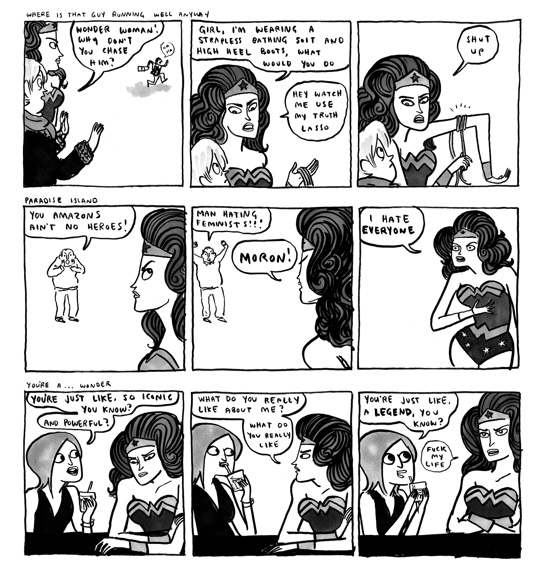
We’ve yet to review a Kate Beaton book here at tQ, but this certainly hasn’t hindered her rise to fame. She’s a brilliant example of someone who has built a career from putting her work online for free. Her Hark!, A Vagrant/ webcomic is enormously successful and has now been turned into a second print book, Step Aside, Pops.
Beaton’s popularity is not the result of producing something so broad it appeals to everyone, but by producing something that appeals to countless niche groups that accumulate to a huge audience. Particularly beloved by fans of history and literature, her work is simultaneously witty and erudite, as every single reviewer is rightly compelled to point out. At the same time, she doesn’t intimidate – the gags are always accessible and often footnoted. Her format – which Beaton playfully acknowledged in her contribution to the introduction of Drawn & Quarterly 25 – is extremely successful. It’s also very, very funny – she has a real talent for taking something small and running with it. There are a number of strips that start with an old illustration or book cover and are then expanded for several more panels that are hysterical. The straw feminists pages are also particular highlights, and demonstrate how effective Beaton’s eyes are, despite their simplicity. She has a somewhat scratchy drawing style, which feels very honest, like she has managed to capture exactly what she intended rather than refined it to the point where the spark has gone. This is an excellent book, which unsurprisingly showed up in many best of the year lists. Pete Redrup
Jeremy Sorese – Curveball
(Nobrow)

It never hurts when a book looks great, and boy, does this look great: title descending down the left, dark and mysterious picture, and orange. Orange stripe, orange in the picture, orange obi strip and mock gilt edges in orange. Open the book and the orange continues, with it appearing throughout alongside the otherwise duotone art. Nobrow have done a killer job in putting this together. Curveball is a sci-fi comic, but to describe it thus doesn’t really capture what it’s about – it’s more accurately a love story in a sci-fi setting. It’s set in a future where our relationship with technology and energy has changed, but where love and war remain constants, a world where robots are ever-present but are starting to emotionally break down in the energy crisis that is taking place. Early on we get to see a PSA (in orange on white – not one for reading in bed or in dim light) that outlines this crisis. It’s a little expository about something that would doubtless be pretty well known to those people living through it, explaining how energy is recycled through ‘leaping’ from one use to another.
Avery is a waiter who can’t get beyond a doomed relationship with sailor Christophe. Sorese has used an interesting device with Avery, whereby there is no clear indication of gender. The hairstyles, much of the clothing and images in general are often gender ambiguous, and there is repeated reference to Avery as ‘Mx’ rather than something more specific. Avery’s roommate Jacqueline is addressed as ‘Miss Howard’, so this isn’t some futuristic evolution of titles to remove not only marital status but also gender. This is a little clumsily handled at times, such as when a discussion between Jacqueline and Christophe circumnavigates identification of Avery with the plural ‘their’ to avoid using ‘her’ or ‘his’, but it produces an interesting effect allowing easier identification with the protagonist, and it’s not easy to think of a better way of handling this. Intriguingly, whilst the book and the cover blurb stay gender ambiguous, Nobrow’s catalogue does not.
Sorese uses varied page layouts – sometimes panelled, sometimes not, and sometimes backgrounds used for additional illustration. There’s variation in panel sizes and placement where they are used. Sorese is a very talented artist, and this book is a delight to look at. There are more than a few Charles M. Schultz stylistic traits with the soft shapes and round heads – there’s a signature ‘aaugh’ in all but words in more than one panel, and his drawing brilliantly captures emotion. Narratively, these very human characters are woven into a sprawling, occasionally confusing story, and at times the book feels like it could have benefited from a more judicious editing process. However, this is an ambitious, heartfelt and very original work that is a feast for the eyes and is well worth checking out. Sorese is enormously talented as anyone who saw his comic diary at TCJ will be aware, and this is an impressive debut. Pete Redrup
Simon Spurrier and Ryan Kelly – Cry Havoc #1
(Image)
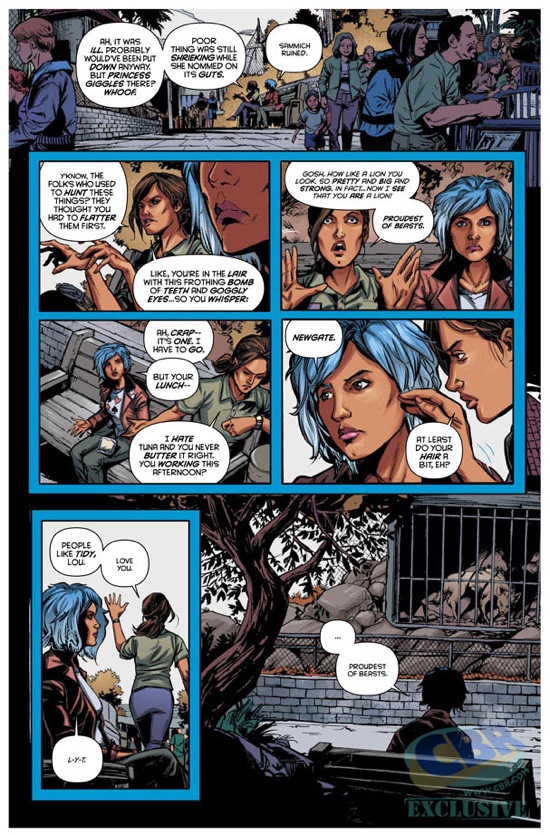
You too will be frantically searching the net within a couple of pages of this new series, to find out if a female hyena really does wear her vagina on the outside like a penis, making her “functionally unrapeable”. It turns out they do, which is an attention-grabbing fact to start with from writer Spurrier. Known from his time with 2000AD, Marvel and increasingly a series of self-initiated projects as a writer of fierce, almost overwhelming tastes in weirdness, Spurrier has been at pains to point out that this isn’t just a lesbian werewolf story… but that it kind of is too. His sense of narrative playfulness is extreme, dragging his lead Louise from her werewolf ‘mugging’ in the city of London, to a pub in Dalston where she plays in a band with her girlfriend, to an abandoned interrogation facility in Afghanistan where she and a bunch of other supernatural grunts are tasked with locating their rogue commanding officer, Apocalypse Now-style. The storytelling is sharp and compulsive, the characters human and the politics edgy but not force-fed. Wow. We’re sold. David Pollock
Katriona Chapman – Katzine
(Self published)
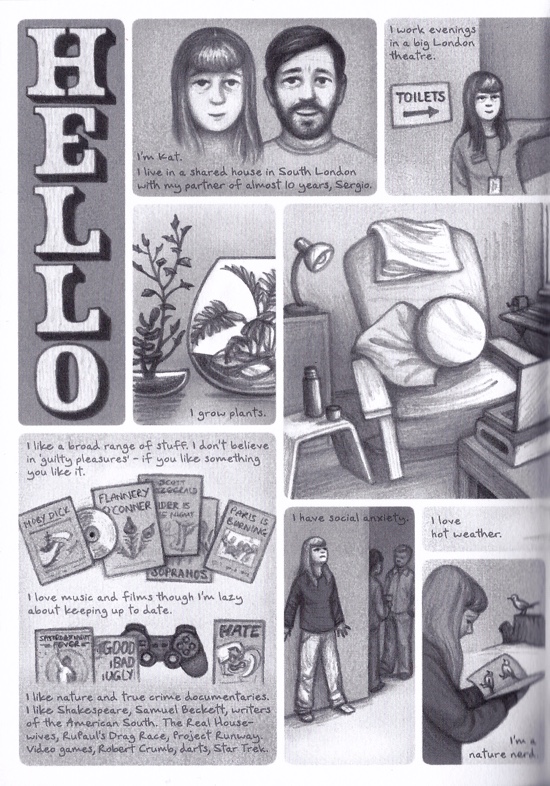
Reading Kat Chapman’s quarterly comic confidences is like being beckoned into the cosiest corner of a really lovely pub or tearoom, sat down in a comfy chair by a warm fire, and leaning in close to hear her speaking so softly, and just telling you what it is like to be alive. There are no sharp corners or hard edges to either Chapman’s writing or her lovely drawing, where the tones are so softly melting and the edges so rounded, even the paper has a textured, high quality feel that makes the reading experience smoothly tactile. But the work is far from sentimental. It feels utterly, sometimes brutally honest. Each issue contains certain regular features, such as a double page spread detailing one of the author’s fears and one of her loves (a concept borrowed from the namechecked Mental Illness Happy Hour), cute or funny things that Kat’s partner Sergio says, interspersed between travelogue comics, wry observations on nerdy topics and frank stories of anxiety and bittersweet experiences. There’s a sort of incisive yet static quality to the stories, as if they’ve been pondered and polished to the point where the purest meaning can be laid out. Very readable, but the sort of stories you want to come back to and read again, to ponder their meaning yourself. This is best evoked when the words and pictures are balanced; I sometimes found the pages with more text than images a little dense, but for the most part, and at risk of using a buzzword, I’d say this is the perfect comic for the switched on, laid back, mindfulness generation that craves to fully experience the moment.
Katzine comes out every 3 months. So far issues 1-4 have been released. My favourite parts so far are the drawings of mountains in issue three. – Jenny Robins
Jack Teagle – The Unmentionables
(Retrofit/Big Planet)
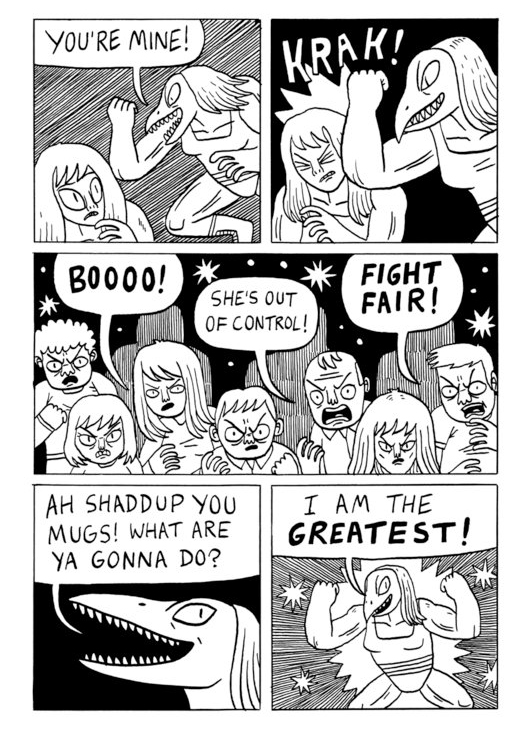
Jack Teagle seems to see the world through the hyper exaggerated and yet whimsically naïve eyes of a small child saving the world. Like many of his previous comic and illustration works, <a href=” http://jackteagle.bigcartel.com/product/unmentionables-comic” target=”out”> The Unmentionables mixes super hero antics with deadpan visual puns and banal internal monologues creating a frenetic, contemporary, utterly unglamorous and darkly humorous take on the classic comic genre. Lizard Woman, Mr Muscles and Bea (Bee) are professional wrestlers who dress up in costumes to stage dramatic fights for paying audiences. When circumstance demands they take these skills into the streets to fight crime; the parallels between the real life profession and the fantasy are obvious. In fact stating the obvious seems to be the main super power the characters in this comic possess, but at times this is hilariously well framed. While disarmingly simple, Teagle’s layers upon layers of irony give his work a uniquely dry appeal, like Mr Benn meets Buffy the Vampire Slayer, and should be enjoyed by any adult who remembers being a small child daydreaming about saving the world. Jenny Robins

